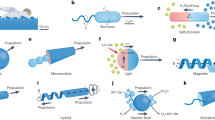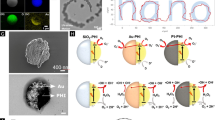Abstract
Currently, there is an increasing interest in handling, understanding, and integrating biological systems important for biomedicine, process industry, pharmacy, and biomaterial research. Besides this interest, the demand for adequate, nondestructive, automatable, and fully controllable handling, manipulation, and characterization techniques increases as well. Thanks to the advancements in micro- and nanofabrication and in the robotics area, several approaches and techniques offer us the ability to set up robotic systems, which are able to handle biomaterials down to the nanoscale. In this chapter, some of the most applicable techniques for a robotic and automated use are shown, including advantages and disadvantages as well as current applications and the necessary biological backgrounds for the most common biomaterials a researcher will handle today. So the state of the art for the nanohandling of biomaterials, applicable in current robotic systems and possibly applicable in future robotic systems, is shown as well as our own work on this special field of research.
Access this chapter
Tax calculation will be finalised at checkout
Purchases are for personal use only
Similar content being viewed by others
References
Alberts B et al (2002) Molecular biology of the cell. Taylor & Francis, New York
Layton BE et al (2005) Nanomanipulation and aggregation limitations of self-assembling structural proteins. Microelectron J 36:644–649
Fahlbusch S, Mazerolle S, Breguet JM (2005) Nanomanipulation in a scanning electron microscope. J Mater Proc Technol 167:371–382
Tai SSW, Tang XM (2001) Manipulating biological samples for environmental scanning electron microscopy observation. Scanning 23:267–272
Mestres P, Pütz N, Laue M (2007) Consequences of tilting of biological specimens in wet mode ESEM imaging. Microsc Microanal 13:244–245
Stokes D (2003) Low vacuum & ESEM imaging of biological specimens. Microsc Microanal 9:190–191
Muscariello L, Rosso F, Marino G (2005) A critical overview of ESEM applications in the biological field. J Cell Physiol 205:328–334
Quate G, Gerber CF, Binnig C (1986) Atomic force microscope. Phys Rev Lett 56:930–933
Castillo J, Dimaki M, Svendsen WE (2009) Manipulation of biological samples using micro and nano techniques. Integr Biol 1:30–42
Lal R, John SA (1994) Biological applications of atomic force microscopy. Am J Physiol Cell Physiol 266:c1–c21
Sitti M (2007) Microscale and nanoscale robotics systems [grand challenges of robotics]. IEEE Robot Autom Mag 14:53–60
Rubio-Sierra J, Heckl W, Stark RW (2005) Nanomanipulation by atomic force microscopy. Adv Eng Mater 7:193–196
Brufau J, Puig-Vidal M, López-Sánchez J (2005) Micron: small autonomous robot for cell manipulation applications. In: International conference on Robotics and Automation, Barcelona, Spain, 856–861
Ando T, Uchihashi T, Kodera N (2008) High-speed AFM and nano-visualization of biomolecular processes. Eur J Physiol 456:211–225
Kuznetsov Y, Gershon PD, McPherson A (2008) Atomic force microscopy investigation of vaccinia virus structure. J Virol 82:7551–7566
Laney DE, Garcia RA, Parsons SM, Hansma HG (1997) Changes in the elastic properties of cholinergic synaptic vesicles as measured by atomic force microscopy. Biophys J 72:806–813
Seidel R, Colombi Ciacchi L, Weigel M, Pompe W, Mertig M (2004) Synthesis of platinum cluster chains on DNA templates: conditions for a template-controlled cluster growth. J Phys Chem B 108:10801–10811
de Pablo PJ, Moreno-Herrero F, Colchero J (2000) Absence of dc-conductivity in λ-DNA. Phys Rev Lett 85:4992–4995
Kufer SK, Puchner EM, Gumpp H, Liedl T, Gaub HE (2008) Single-molecule cut-and-paste surface assembly. Science 319:594–596
Parra A, Casero E, Lorenzo E, Pariente F, Vázquez L (2007) Nanomechanical properties of globular proteins: lactate oxidase. Langmuir 27:2747–2754
Stark RW, Rubio-Sierra J, Thalhammer S, Heckl W (2003) Combined nanomanipulation by atomic force microscopy and UV-laser ablation for chromosomal dissection. Eur Biophys J 32:33–39
Afrin R, Alam MT, Ikai A (2005) Pretransition and progressive softening of bovine carbonic anhydrase II as probed by single molecule atomic force microscopy. Protein Sci 14:1447–1457
Schaap I, Carrasco C, de Pablo PJ, MacKintosh FC, Schmidt CF (2006) Elastic response, buckling, and instability of microtubules under radial indentation. Biophys J 91:1521–1531
Abu-Lail NI, Camesano TA (2003) Polysaccharide properties probed with atomic force microscopy. J Microsc 212:217–238
Peng L et al (2004) Study on biological effect of la3+ on Escherichia coli by atomic force microscopy. J Inorg Biochem 98:68–72
Ebner A et al (2005) Localization of single avidin-biotin interactions using simultaneous topography and molecular recognition imaging. Chem Phys Chem 6:897–900
Oberleithner H et al (2004) Human endothelium: target for aldosterone. Hypertension 43: 952–956
Ivanovska IL et al (2004) Bacteriophage capsids: tough nanoshells with complex elastic properties. Proc Natl Acad Sci 101:7600–7605
Cohen H et al (2006) Electrical characterization of self-assembled single- and double-stranded DNA monolayers using conductive afm. Faraday Discuss 131:367–376
Wright WH, Sonek GJ, Berns MW (1993) Radiation trapping forces on microspheres with optical tweezers. Appl Phys Lett 63:715–717
Ashkin A (1997) Optical trapping and manipulation of neutral particles using lasers. Proc Natl Acad Sci USA 94:4853–4860
Wright WH, Sonek GJ, Tadir Y, Berns MW (1990) Laser trapping in cell biology. IEEE J Quantum Electron 26:2148–2157
Barton JP, Alexander DR (1989) Fifth order corrected electromagnetic field components for a fundamental Gaussian beam. J Appl Phys 66:2800–2802
Svoboda K, Block SM (1994) Biological applications of optical forces. Annu Rev Biophys Biomol Struct 23:247–285
Ruiz I, Wang P, Schaffer C, Kleinfeld D, (2003) Optical trapping and ablation. Neurophysics laboratory final report PHYS 173/BGGN 266 Lab. Uiversity of California, San Diego, CA
Guck J et al (2001) The optical stretcher: a novel laser tool to micromanipulate cells. Biophys J 181:767–784
Baumann CG, Smith SB, Bloomfield VA, Bustamante C (1997) Ionic effects on the elasticity of single DNA molecules. Proc Natl Acad Sci USA 94:6185–6190
Yu Y (2003) Introduction to probing DNA with optical tweezers. Introduction to Biophysics - Term Paper
Arai Y, Yasuda R, Akashi K (1999) Tying a molecular knot with optical tweezers. Lett Nat 399:446–448
Tai CH, Hsiung SK, Chen CY, Tsai ML, Lee GB (2007) Automatic microfluidic platform for cell separation and nucleus collection. Biomed Microdevices 9:533–545
Yang J, Huang Y, Wang XB, Becker FF, Gascoyne PRC (1999) Cell separation on microfabricated electrodes using dielectrophoretic/gravitational field-flow fractionation. Anal Chem 71:911–918
An J, Lee J, Kim Y, Kim B, Lee S (2008) Analysis of cell separation efficiency in dielectrophoresis-activated cell sorter. In: 3rd International IEEE conference on nano/micro engineered and molecular systems, 965–969
Yang J, Huang Y, Wang XB, Becker FF, Gascoyne PRC (2000) Differential analysis of human leukocytes by dielectrophoretic field-flow-fractionation. Biophys J 78:2680–2689
Wang XB et al (2000) Cell separation by dielectrophoretic field-flow-fractionation. Anal Chem 72:832–839
Regtmeier J, Duong TT, Eichhorn R, Anselmetti D, Ros A (2007) Dielectrophoretic manipulation of DNA: separation and polarizability. Anal Chem 79:3925–3932
Tuukkanen S, Kuzyk A, Toppari JJ (2007) Trapping of 27 bp-8 kbp DNA and immobilization of thiol-modified DNA using dielectrophoresis. Nanotechnology 18:295204–295214
Sun Y, Nelson BJ (2002) Biological cell injection using an autonomous microrobotic system. Int J Robot Res 21:861–868
Mølhave K, Wich T, Kortschack A, Bøggild P (2006) Pick-and-place nanomanipulation using microfabricated grippers. Nanotechnology 17:2434–2441
Carlson K, Andersen KN, Eichhorn V (2007) A carbon nanofibre scanning probe assembled using an electrothermal microgripper. Nanotechnology 18:345501–345508
Sardan O et al (2007) Microgrippers: a case study for batch-compatible integration of MEMS with nanostructures. Nanotechnology 18:375501–375512
Kim P, Lieber CM (1999) Nanotube nanotweezers. Science 286:2148–2150
Bøggild P, Hansen TM, Tanasa C, Grey F (2001) Fabrication and actuation of customized nanotweezers with a 25 nm gap. Nanotechnology 12:331–335
Hashiguchi G, Goda T, Hosogi M (2003) DNA manipulation and retrieval from an aqueous solution with micromachined nanotweezers. Anal Chem 75:4347–4350
Beyeler F, Neild A, Oberti S (2007) Monolithically fabricated microgripper with integrated force sensor for manipulating microobjects and biological cells aligned in an ultrasonic field. J Microelectromech Syst 16:7–15
Chronis N, Lee LP (2005) Electrothermally activated SU-8 microgripper for single cell manipulation in solution. J Microelectromech Syst 14:857–863
Kim K, Liu X, Zhang Y, Sun Y (2008) Nanonewton force-controlled manipulation of biological cells using a monolithic MEMS microgripper with two-axis force feedback. J Micromech Microeng 18:55013–55021
Solano B, Wood D (2007) Design and testing of a polymeric microgripper for cell manipulation. Microelectron Eng 84:1219–1222
Blideran MM, Bertsche G, Henschel W, Kern DP (2006) A mechanically actuated silicon microgripper for handling micro- and nanoparticles. Microelectron Eng 83:1382–1385
Sokolov I, Subba-Rao V, Luck LA (2006) Change in rigidity in the activated form of the glucose/galactose receptor from Escherichia coli: a phenomenon that will be key to the development of biosensors. Biophys J 90:1055–1063
Blideran MM, Fleischer M, Henschel W (2006) Characterization and operation of a mechanically actuated silicon microgripper. J Vac Sci Technol B 24:3239–3243
Author information
Authors and Affiliations
Corresponding author
Editor information
Editors and Affiliations
Rights and permissions
Copyright information
© 2013 Springer Science+Business Media, LLC
About this chapter
Cite this chapter
Weigel-Jech, M., Fatikow, S. (2013). Nanohandling of Biomaterials. In: Mavroidis, C., Ferreira, A. (eds) Nanorobotics. Springer, New York, NY. https://doi.org/10.1007/978-1-4614-2119-1_11
Download citation
DOI: https://doi.org/10.1007/978-1-4614-2119-1_11
Published:
Publisher Name: Springer, New York, NY
Print ISBN: 978-1-4614-2118-4
Online ISBN: 978-1-4614-2119-1
eBook Packages: EngineeringEngineering (R0)




